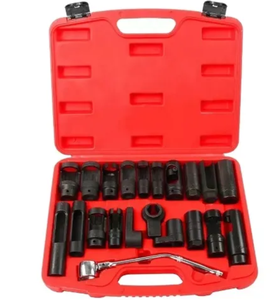(437 products available)





















































































































































































There are several types of oxygen sensor socket sets available. They include:
1. 22mm Oxygen Sensor Socket Set
This is a popular size for many vehicles. It is used to remove and install oxygen sensors without damaging them. The 22mm oxygen sensor socket comes in a set with different types of sockets. They include: 22mm 6-point, 12-point, and E-Torx sockets. This allows for more versatility and use on different vehicles.
2. 7/8-inch Oxygen Sensor Socket Set
The 7/8-inch oxygen sensor socket set is equivalent to the 22mm size. It is also used on many vehicles, especially older models. Like the 22mm set, it comes with different types of sockets in 7/8-inch size. They include: 7/8-inch 6-point, 12-point, and E-Torx sockets. This allows for more versatility and use on different vehicles.
3. 3/8-inch Drive Oxygen Sensor Socket Set
The 3/8-inch drive oxygen sensor socket set is not a size of the actual sockets. Instead, it refers to the size of the ratchet or handle that is used with the sockets. A 3/8-inch drive is the most common size. It is used on many vehicles, especially older models. The 3/8-inch drive oxygen sensor sockets typically have 22mm or 7/8-inch sizes.
4. 1/2-inch Drive Oxygen Sensor Socket Set
>The 1/2-inch drive oxygen sensor socket set is not a size of the actual sockets. Instead, it refers to the size of the ratchet or handle that is used with the sockets. A 1/2-inch drive is the most common size. It is used on many vehicles, especially older models. The 1/2-inch drive oxygen sensor sockets typically have 22mm or 7/8-inch sizes.
An oxygen sensor socket set is a specialized toolset designed for the maintenance and repair of vehicles' oxygen sensors. These sensors are critical components of a vehicle's emissions and fuel efficiency systems, making it essential to handle them with care. While the specific contents of an oxygen sensor socket set may vary depending on the manufacturer, here are some common tools and their specifications:
Maintaining an oxygen sensor socket set is crucial to ensure its longevity and optimal performance. Here are some maintenance tips:
When buying an oxygen sensor socket set, always consider the needs of the target market. Here are some factors to help choose the right tools for the market.
Every car model has a different sensor location and a different type of bolt that holds the sensor in place. Some vehicles use flat bolts or hex bolts, while others use 12-point or bi-hex bolts. Before buying a socket, check the vehicle's service manual to know the sensor location and type of bolt used. The manual will also give information about the vehicle's exhaust system layout. Bending or damaging the exhaust pipes when replacing the sensor could cause further damage. A socket with a 3/8-inch or 1/2-inch drive is suitable for almost all vehicle oxygen sensor installations.
The size of the oxygen sensor socket is also important when choosing a set. Sockets come in various sizes suitable for different sensor types. For instance, standard-sized sensors measure about 18 mm and are widely used in most vehicles. However, some manufacturers use slightly smaller or larger sensor sizes. This makes it difficult to remove or replace the sensor without damaging it.
Consider the material used to make the oxygen sensor socket set. Carbon steel and chrome vanadium are strong enough to withstand the demands of everyday use. Chrome molybdenum is more durable than other metals, but it is also more expensive. If the budget allows, consider buying sockets made from chrome-molybdenum steel. They are corrosion-resistant and can last for many years with proper care.
Decide whether to buy a single socket or a complete socket set. A complete set comes with multiple sizes and is ideal for workshops that handle various vehicle models. Some suppliers on Alibaba.com offer customized socket sets with different sizes to cater to specific client needs. The workshop may also have existing sockets. Therefore, it is best to confirm the required sizes before placing an order.
Finally, consider the budget and whether to buy from a wholesale supplier or retail. It is more cost-effective to buy from a supplier on Alibaba.com. Some retailers offer free shipping and a warranty, making their products affordable.
Follow these steps to replace an oxygen sensor safely:
Q1: How frequently must an oxygen sensor be replaced?
A1: Oxygen sensors should typically be changed every 60,000 to 100,000 miles. However, the precise interval may change depending on the car's make and model as well as the driving circumstances.
Q2: What indications point to a failing oxygen sensor?
A2: A faulty oxygen sensor can cause a variety of performance issues, including a decrease in fuel efficiency, an increase in exhaust emissions, engine performance issues, and check engine light activation. Additionally, it's possible that the sensor will cause the engine to run in an inadequate or rich condition.
Q3: Is it possible to drive with a faulty oxygen sensor?
A3: While it may be feasible to drive with a faulty oxygen sensor, it is not advised. The sensor is essential for controlling fuel efficiency and emissions; hence, it influences the performance of the car. Driving with a compromised oxygen sensor can harm the engine, reduce fuel efficiency, and raise exhaust emissions.
Q4: Can one replace an oxygen sensor independently?
A4: Yes, replacing an oxygen sensor is a relatively straightforward DIY operation. Using an oxygen sensor wrench, one may generally accomplish it with basic mechanical expertise and the proper tools. It is crucial to adhere to the manufacturer's instructions, however, because different automobiles have different sensor placements.
Q5: Is there a warranty on new oxygen sensors?
A5: Yes, a warranty is often included with new oxygen sensors. The warranty duration may vary depending on the manufacturer and the sensor's quality. It is crucial to keep the receipt and have the sensor fitted by a qualified mechanic to uphold the warranty in many situations.